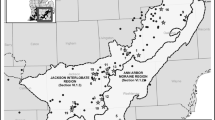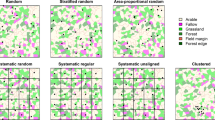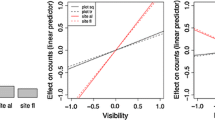Abstract
The loss of small, seasonal wetlands is a major concern for a variety of state, local, and federal organizations in the northeastern U.S. Identifying and estimating the number of vernal pools within a given region is critical to developing long-term conservation and management strategies for these unique habitats and their faunal communities. We use three probabilistic sampling methods (simple random sampling, adaptive cluster sampling, and the dual frame method) to estimate the number of vernal pools on protected, forested lands. Overall, these methods yielded similar values of vernal pool abundance for each study area, and suggest that photographic interpretation alone may grossly underestimate the number of vernal pools in forested habitats. We compare the relative efficiency of each method and discuss ways of improving precision. Acknowledging that the objectives of a study or monitoring program ultimately determine which sampling designs are most appropriate, we recommend that some type of probabilistic sampling method be applied. We view the dual-frame method as an especially useful way of combining incomplete remote sensing methods, such as aerial photograph interpretation, with a probabilistic sample of the entire area of interest to provide more robust estimates of the number of vernal pools and a more representative sample of existing vernal pool habitats.
Similar content being viewed by others
Literature Cited
Alpizar-Jara, R., K. H. Pollock, and D. E. Haines. 2005. Markrecapture estimators for dual frame population size of prominent nesting structures: the effect of uncertain detection probability. Environmental and Ecological Statistics 12: 155–68.
Armstrong, D. P. 2005. Integrating the metapopulation and habitat paradigms for understanding broad-scale declines of species. Conservation Biology 19: 1402–10.
Brooks, R. T., J. Stone, and P. Lyons. 1998. An inventory of seasonal forest ponds on the Quabbin Reservoir watershed, Massachusetts. Northeastern Naturalist 5: 219–30.
Brown, J. A. 2003. Designing an efficient adaptive cluster sample. Environmental and Ecological Statistics 10: 95–105.
Burne, M. R. 2001. Massachusetts aerial photo survey of potential vernal pools. Natural Heritage and Endangered Species Program, Department of Fisheries and Wildlife, Westborough, MA, USA.
Burne, M. R. and R. G. Lathrop. 2008. Remote and field identification of vernal pools. p. 55–68, In A. J. K. Calhoun and P. K. deMaynadier (eds.) Science and Conservation of Vernal Pools in Northeastern North America. CRC Press, Boca Raton, FL, USA.
Calhoun, A. J. K. and P. K. deMaynadier (eds.). 2007. Science and Conservation of Vernal Pools in Northeastern North America. CRC Press, Boca Raton, FL, USA.
Calhoun, A. J. K., T. E. Walls, S. S. Stockwell, and M. McCollough. 2003. Evaluating vernal pools as a basis for conservation strategies: a Maine case study. Wetlands 23: 70–81.
DiMauro, D. and M. L. Hunter, Jr. 2002. Reproduction of amphibians in natural and anthropogenic temporary pools in managed forests. Forest Science 48: 397–406.
Goldberg, N. A., J. N. Heine, and J. A. Brown. 2007. The application of adaptive cluster sampling for rare subtidal macroalgae. Marine Biology 151: 1343–48.
Grant, E. H. C. 2005. Correlates of vernal pool occurrence in the Massachusetts, USA landscape. Wetlands 25: 480–87.
Haines, D. E. and K. H. Pollock. 1998. Estimating the number of active and successful bald eagle nests: an application of the dual frame method. Environmental and Ecological Statistics 5: 245–56.
Julian, J. T., C. D. Snyder, and J. A. Young. 2006. The use of artificial impoundments by two amphibian species in the Delaware Water Gap National Recreation Area. Northeast Naturalist 13: 459–68.
Lathrop, R. G., P. Montesano, J. Tesauro, and B. Zarate. 2005. Statewide mapping and assessment of vernal pools: a New Jersey case study. Journal of Environmental Management 76: 230–38.
MacKenzie, D. I., J. D. Nichols, J. A. Royle, K. H. Pollock, L. L. Bailey, and J. E. Hines. 2006. Occupancy Estimation and Modeling: Inferring Patterns and Dynamics of Species Occurrence. Academic Press, New York, NY, USA.
Marsh, D. M. and P. C. Trenham. 2001. Metapopulation dynamics and amphibian conservation. Conservation Biology 15: 40–49.
Noon, B. R., N. M. Ishwar, and K. Vasudevan. 2006. Efficiency of adaptive cluster and random sampling in detecting terrestrial herpetofauna in a tropical rainforest. Wildlife Society Bulletin 34: 59–68.
Petranka, J. W., C. K. Smith, and A. F. Scott. 2004. Identifying the minimal demographic unit for monitoring pond-breeding amphibians. Ecological Applications 14: 1065–78.
Philipi, T. 2005. Adaptive cluster sampling for estimation of abundances within local populations of low-abundance plants. Ecology 86: 1091–1100.
Salehi, M. M. 2003. Comparison between Hansen-Hurwitz and Horvitz Thompson estimators for adaptive cluster sampling. Environmental and Ecological Statistics 10: 115–27.
Smith, D. R., J. A. Brown, and N. C. H. Lo. 2004. Application of adaptive sampling to biological populations. p. 77–122. In W. L. Thompson (ed.) Sampling Rare or Elusive Species. Island Press, Washington, DC, USA.
Smith, D. R., R. F. Villella, and D. P. Lemarié. 2003. Application of adaptive cluster sampling to low-density populations of freshwater mussels. Environmental and Ecological Statistics 10: 7–15.
Stone, J. S. 1992. Vernal pools in Massachusetts: aerial photographic identification, biological and physiological characteristics, and state certification criteria. M.S. Thesis. University of Massachusetts, Amherst, MA, USA.
Thompson, S. K. 1990. Adaptive cluster sampling. Journal of the American Statistical Association 85: 1050–59.
Thompson, S. K. and G. Seber. 1996. Adaptive Sampling. John Wiley & Sons, Inc., New York, NY, USA.
Tiner, R. W. 1990. Use of high-altitude aerial photography for inventorying forested wetlands in the United States Forest Ecology and Management 33/34: 593–604.
Weier, J. 2004. Conservation in 3D. Conservation in Practice 5: 39–41.
Author information
Authors and Affiliations
Rights and permissions
About this article
Cite this article
Van Meter, R., Bailey, L.L. & Grant, E.H.C. Methods for estimating the amount of vernal pool habitat in the northeastern United States. Wetlands 28, 585–593 (2008). https://doi.org/10.1672/07-237.1
Received:
Accepted:
Issue Date:
DOI: https://doi.org/10.1672/07-237.1




